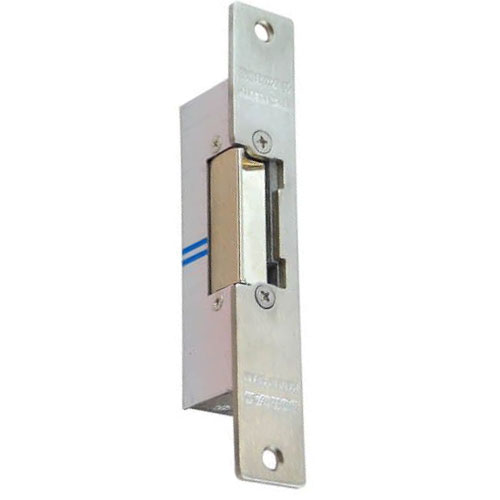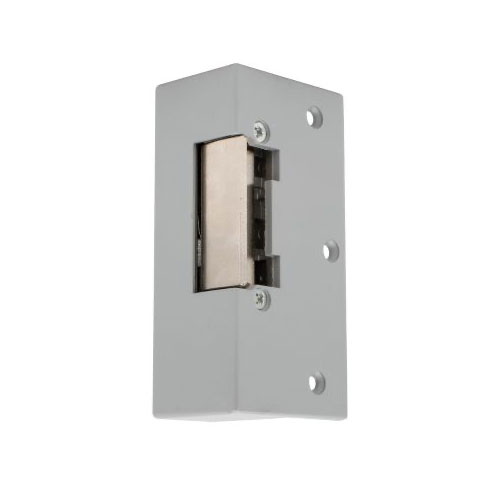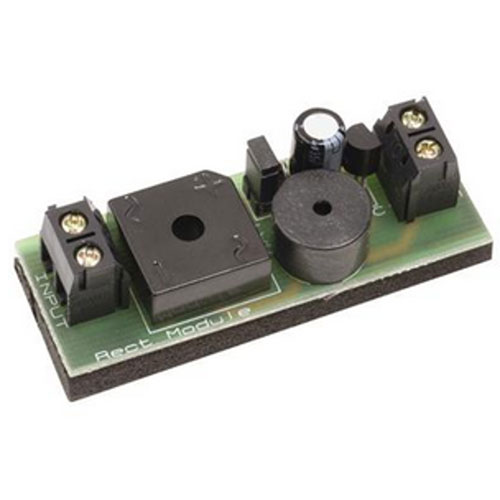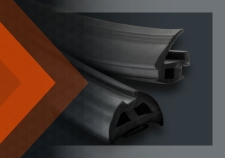
In this guide, we’ll look at the various different types of electric release and give you some tips to help ensure that you can identify the correct product.
All of our electric releases can be found here
7 essential questions to identify an electronic release:
- 1. What type of electric release is it? (Mortice or Rim)
- 2. Is the electric release ANSI or Euro Style?
- 3. What is the voltage of the electric release? (12V/24V)
- 4. What current (AC/DC) does the electric release have?
- 5. Is the strike monitored or unmonitored?
- 6. Is the electric release Fail Safe or Fail Secure?
- 7. What are the dimensions of the electric release?
1. What type of electric release is it?
When we talk about the type of electric release we mean the way it is fitted to the door. There are two main types of electronic release:

Mortice Electric Release

Rim Electric Release
*NOTE some electronic releases supplied by Duffells, such as the TSS European Style Rim / Mortice Release 12v AC/DC come with both Mortice and Rim faceplates, so can be used as either type. Always check the description to see if both Rim and Mortice faceplates are supplied.
2. Is the electric release ANSI or Euro style?
There are several common styles of electric release. The two most common styles we come across, are ANSI and European style electronic releases. ANSI refers to the American National Standards Institute. ANSI releases are made to standardized measurements and have a recognizable appearance which makes them easy to spot compared to the standard, cheaper, European-style electronic releases.
ANSI Style Electric Release

European Style Electric Release

Here are some examples of common ANSI style electronic releases:

As you can see, they are robust units with large stainless jaws that open in a radial action as opposed to a hinged jaw as seen on cheaper European type releases. We’d always recommend the Trimec ES110 Electric Release when considering an ANSI-style electric release. Just be sure that the size matches your existing release.
3. What is the voltage of the electric release? (12V/24V)
The next piece of information you will require is the operating voltage.
This will usually be either 12Volt (12V) or 24Volt (24V). Some strikes can run on either, as their operating voltage will range from 12V to 24V. Only the information on site can tell you this information, we cannot identify the operating voltage, and installing a strike to a system that is running an incompatible voltage may cause electrical damage.
To help identify the voltage of the system it is necessary to either test the system with a meter or check the power supply which should have a sticker featuring the output type. Sometimes the old release itself will feature a sticker showing the suitable operating voltage.
THIS INFORMATION WILL ALWAYS BE REQUIRED TO IDENTIFY A SUITABLE REPLACEMENT.
4. What current (AC/DC) does the electric release have?
This information can usually be found in the same place as the Voltage, or again by testing the system with a meter. A lot of the releases we are asked for will be DC as that is most common on Access Control systems, however, there are a good amount of AC strikes, for example on older intercoms systems, and it is important to be sure which current type the system is using.
Rectifier Modules (such as the RM1 Rectifier Module for converting AC to DC), are available which enable DC releases to be used on AC systems.

5. Is the strike monitored or unmonitored?
Next, we need to identify if the strike is monitored or unmonitored. Monitoring means the strike uses small switches to answer questions, such as; “Is the door shut?” or “Is the lock in the locked or unlocked position?” Some strikes will monitor several things at once. This strike uses a small switch (labeled in the image below) in the keep to monitor whether the lock bolt is thrown. When the latch is thrown it presses the switch, letting the access control system know the latch of the lock is in the closed position….

Here is another example showing how the latch engages the switch…

This is known as “lock status monitoring” as the switch reveals the status of the latch in the lock case. Other things that are often monitored include door status monitoring where a small switch or sensor identifies if the door is in the open or closed position relative to the frame.
6. Is the electric release Fail Safe or Fail Secure?
Next, we will look at how to identify if a release is Fail-Safe or Fail-Secure. This is a very important variation, which must be fully understood to ensure the correct product is identified.
Fail Safe
It may also be referred to as the following:
- Fail Unlocked
- Power To Lock
- T.L.
This means that when the lock is receiving no power, as in is disconnected from the door, the Jaw is not locked in position, and can be pushed open.
The customer would be able to push the jaw in, or open, with their hands, and if still fitted, the door will simply push open if there is no power supply connected.
When power is supplied to the release, the solenoid changes position and the Jaw is physically blocked from moving. This locks the jaw and prevents the door from being opened. What this means is that when fitted, the release requires a constant supply of power to secure the door.
When the user wishes to open the door, enter, or exit, the power supply is interrupted and terminated temporarily to allow the door to be opened. This is useful for applications where safety is paramount, to ensure that if the power supply was lost in an emergency, people would be able to escape the building as the door would default to the unlocked position.
Fail Secure
It may also be referred to as the following:
- Fail Locked
- Power To Open
- T.O.
This means that when the release is not receiving power and is totally disconnected, the jaw is blocked from moving and cannot be opened.
With the release removed, someone would not ordinarily be able to push the jaw in with their hands, and if it were fitted to the door, would be unable to push the door open.
When the release receives a supply of power, the solenoid position changes, and the jaw is no longer blocked, meaning the door can be opened. This means that when the release has been fitted, it only receives a supply of power each time the user wishes to open the door.
This saves on electricity consumption but means that in the event of a power failure, the door remains secure and cannot be pushed open. This would only be used in situations where the need for security outweighs the requirement for safe egress of the building.
In either case, the wiring differs depending on what type of electric release is being used. It is not possible to simply replace a fail-safe release with a fail secure as it will not work in the correct manner. It is important to always identify what the original was and replace like for like, unless fundamental changes are to be made to the wiring of the system.
7. What are the dimensions of the electric release?
Finally, as with all products, to identify the best possible replacement for a product, we must ensure to check the product's dimensions. The more sizes we obtain the easier the task of identifying the product. With electronic releases, the following dimensions are required:
- Faceplate size (height x width)
- Body Size (height x width x depth)
- Jaw Depth
- Jaw Height
- Lip projection (ANSI Style only)

To summarise, when asked to identify an electronic release you will need the following information every time to ensure that you receive a suitable replacement.
- 1. What type of electric release is it? (Mortice or Rim)
- 2. Is the electric release ANSI or Euro Style?
- 3. What is the voltage of the electric release? (12V/24V)
- 4. What current (AC/DC) does the electric release have?
- 5. Is the strike monitored or unmonitored?
- 6. Is the electric release Fail Safe or Fail Secure?
- 7. What are the dimensions of the electric release?
We hope you find this guide helpful in understanding how to identify an electric release. Should you have any further questions please do not hesitate to contact our team.





